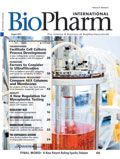Downstream Disposables: The Missing Link in the Disposables Chain
Although single-use systems are widely used in upstream unit operations, their acceptance in downstream processes has been slow.
One of the biggest trends in biopharmaceutical manufacturing over the past few years has been the increasing use of single-use systems for biomanufacturing. Nevertheless, although disposables are commonly used in upstream processes, their use in downstream operations is not so widespread.

Eric Langer
GROWTH IN THE USE OF DISPOSABLES
Our 7th Annual Report and Survey of Biopharmaceutical Manufacturing shows that the growth in the use of disposable systems has steadily increased over the past five years. Significant improvements and product advances have taken place in 2007 to 2009. For example, three years ago, disposable tangential flow filtration (TFF) systems suitable for bench to commercial scale seemed unlikely, but we have them today. According to the survey, the highest average annual growth rate among single-use products was for membrane adsorbers (Figure 1).

Figure 1. Average annual growth rate (2005â2009) for single-use products in all stages of R&D and manufacture (not growth in sales but in application first usage within a facility)
Such incremental improvements in manufacturing are important, but the real industry performance change is likely to occur when all steps in biomanufacturing, including the costly and difficult downstream purification steps, can be made "in a box," using disposable, or modular devices. There are many reasons companies are seeking this kind of solution, including easier cleaning, faster turnaround times, easier validation, and better quality management.
Contract manufacturing organizations (CMOs) are leading the charge, partly because of the need for flexibility in their manufacturing. By enabling flexibility and quick turnaround times between process runs, disposables enable CMOs to perform different processes more efficiently within a given facility. These efficiencies can reduce operating costs and capital investments. These savings then can be passed on to the client.
"The transition of small- and mid-scale biopharmaceutical manufacturing processes to single-use systems is almost complete," says Geoff Hodge, VP of technology at Xcellerex, noting that depth filtration harvests, filtration steps including tangential flow and virus filtration can all be addressed with single-use solutions. Xcellerex now routinely uses disposable flow paths for its chromatography steps too. "These, coupled with pre-packed columns, offer an opportunity for us to dedicate columns to a single customer campaign and eliminate any product contact crossover from one campaign to the next," he says. "In most cases, single-use sensors are available off the shelf to support downstream operations."
DISPOSABLES IN DOWNSTREAM
As the industry shifts its attention to purification capacity and cost, new technologies such as continuous processing, multi-column chromatography, and expanded bed chromatography are being developed to address downstream processing bottlenecks. In most new downstream technologies, vendors are incorporating single-use systems.
Nevertheless, although single-use systems are widely accepted and used in upstream unit operations, their acceptance in downstream processes has been slow. In our survey, we also measured manufacturers' and CMOs' current use of single-use systems at all stages, from R&D through commercial production. Most respondents currently use disposable filter cartridges (94.2%), but products like membrane adsorbers (45.8%) remain at the bottom of the list again this year. In particular, the use of membrane adsorbers to replace Protein A remains a challenge for the industry, although data indicate it is slowly gaining ground.
Companies such as Xcellerex, Millipore, Sartorius, and Hyclone, to name a few, are promoting the use of flexibility in their single-use systems. According to Alfred Dadson, senior director of manufacturing operations at Xoma, "Entirely disposable upstream processes that can support commercialization are a reality, and now companies are focusing on cost-effective downstream single-use innovations."
NEW DOWNSTREAM PROCESSING SOLUTIONS
Our survey identified the top five new technologies and equipment; they all relate to chromatography and methods to reduce its impact as a bottleneck on the process. Another major area for anticipated improvement is filtration and other membrane processes. According to Scott M. Wheelwright, the founder of Strategic Manufacturing Worldwide, "These are historically the major unit operations in downstream processing ... there is work on precipitation and two-phase systems, both of which have the potential to make inroads into established methods for recovery and purification." Similarly, he says, conversion of large proteins to monoclonal antibody fragments or synthetic peptides also has the potential to impact the industry, but based on the [survey] responses, not many people are betting heavily on these alternatives. That means that the innovations in traditional downstream technologies of chromatography and filtration will continue to be important.
SUMMARY
The industry is demanding more flexibility across all unit operations and vendors have responded by developing technologies to improve downstream processes. Our annual study also continues to show downstream processing as the primary bottleneck today, and although no fully commercialized downstream alternative to current chromatography processes exist, a number of products are in development. Once such products are available, more companies will likely increase their overall use of single-use systems. This will make it possible to begin to realize the advantages expected from fully disposable production processes.
In addition, as new regions such as China and India begin to produce biologics and biogenerics intended for Western markets, the need for consistent quality will likely dictate a greater use of disposables, because they can be implemented more efficiently and with fewer risks of quality problems. As new biomanufacturers enter the industry and new products enter the pipeline, the disposables option will become part of the decision process from the very start. This may help start-up organizations and those in less developed regions become more effective and competitive.
Eric Langer is president and managing partner at BioPlan Associates, Inc., Rockville, MD. He is also a member of Biopharm International's ediorial advisory board, 301.921.5979, elanger@bioplanassociates.com

Thermo Fisher Opens Advanced Therapies Collaboration Center in California
April 18th 2025The 6000-square-foot facility will provide cell therapy developers the support they need to transition to CGMP manufacturing, and an expanded footprint of the new center is expected to open in Philadelphia later in 2025.